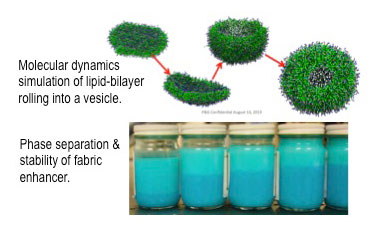One doesn’t normally associate their favorite shampoo or laundry detergent with science, let alone multi-million dollar supercomputers, but in today’s modern world many well-known consumer goods are the products of extensive R&D. By using large-scale computational modeling to facilitate advanced product design, manufacturers can improve customer satisfaction and minimize costly design flaws.
A recent feature article on the Oak Ridge National Laboratory website recounts how the lab’s supercomputing resources enabled Procter & Gamble, the consumer products giant behind such brands as Downy, Head & Shoulders, Olay and Crest, to understand the molecular interactions that control the flow, thickness, performance and stability of P&G products.
Credit: Oak Ridge National Laboratory
Oak Ridge Science Writer Dawn Levy shares how Procter & Gamble and research partners at Temple University leveraged Oak Ridge systems, Jaguar and Titan, to perform challenging molecular dynamics simulations. The research team was specifically working to understand the interplay of fat-soluble molecules called lipids, and lipid vesicles, which are formed from lipid bilayers. Many products for the body and for laundry are comprised of these types of molecules, which directly impact the product’s performance and shelf-life.
“For Procter & Gamble, it is crucial to understand vesicle fusion if you want to extend the shelf lives of such products as fabric softeners, body washes, shampoos, lotions, and the like,” explained Temple’s Michael Klein, a National Academy of Sciences member who has collaborated with P&G for 15 years. “Vesicle fusion is a very hard science problem.”
The addition of perfumes and dyes can also affect stability, making the problem even more complex. Simulating the reorganization of lipid systems over time is thus a very challenging computational problem, surpassing the capabilities of P&G’s in-house machines. To perform these compute-intensive simulations, they turned to what was at the time the fastest supercomputer in the world, Jaguar, which has since been upgraded and re-launched as Titan.
The P&G/Temple University team was awarded time on Jaguar through the Innovative and Novel Computational Impact on Theory and Experiment (INCITE) program, which is jointly managed by the U.S. Department of Energy’s (DOE’s) Leadership Computing Facilities at Argonne and Oak Ridge national laboratories. The researchers accessed 69 million core hours on Jaguar over two years, enabling them to perform simulations of large, complex systems of lipid assemblies.
Because of Jaguar’s powerful capabilities, and also the GPU-equipped Titan prototype, called TitanDev, the team was able to carry out vesicle fusion simulations that had previously not been possible. As Levy concludes, the research highlights the importance of leadership computing facilities for solving “unsolvable” problems and providing a major competitive advantage.





























































